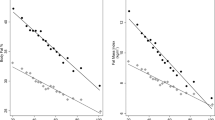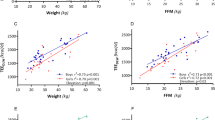Abstract
Background/Objectives:
Obesity is on the rise and participation in exercise has declined. Domestic household activities may help meet the recommended daily physical activity levels. This study aimed to measure the energy costs of household activities among Asian males.
Subjects/Methods:
This was a randomised cross-over study conducted in a whole-body calorimeter. The energy costs of 14 domestic household activities, divided into two studies, were measured in 10 healthy Asian males. Participants’ weight, height, body composition and basal metabolic rate were measured on the first test visit. A standard breakfast was served and participants rested for an hour before the measurement of energy costs of domestic household activities. During the measurements, each activity was performed for 20 min, and participants rested for 30 min between activities.
Results:
The mean energy costs of domestic household activities ranged from 5.92 to 11.97 kJ/min, which were significantly different between activities (repeated measures analysis of variance, P<0.001). When expressed as metabolic equivalents (METS), all domestic household activities were classified as low-intensity physical activities. Actual METS (METSactual) were significantly different to standard METS of eight activities, which may be partly explained by the universal assumption of 3.5 ml O2/kg/min made during the calculation of METS in the Asian population.
Conclusions:
The energy costs of a range of domestic household activities reported in this study may assist in the planning of physical activities among Asians to meet national physical activity guidelines.
This is a preview of subscription content, access via your institution
Access options
Subscribe to this journal
Receive 12 print issues and online access
$259.00 per year
only $21.58 per issue
Buy this article
- Purchase on Springer Link
- Instant access to full article PDF
Prices may be subject to local taxes which are calculated during checkout
Similar content being viewed by others
References
Goh LG, Pang J . Obesity in Singapore, prevention and control. Singapore Fam Physician 2012; 38: 8–13.
Health Promotion Board Report of the National Nutrition Survey 2010. Health Promotion Board: Singapore, 2013.
Chua LAV Personal Health Practices—Different Patterns in Males and Females. Department of Statistics Singapore: Singapore, 2009.
Westerterp KR, Speakman JR . Physical activity energy expenditure has not declined since the 1980 s and matches energy expenditures of wild mammals. Int J Obes 2008; 32: 1256–1263.
Black AE, Coward WA, Cole TJ, Prentice AM . Human energy expenditure in affluent societies: an analysis of 574 doubly-labelled water measurements. Eur J Clin Nutr 1996; 50: 72–92.
Wareham NJ, van Sluijs EM, Ekelund U . Physical activity and obesity prevention: a review of the current evidence. Proc Nutr Soc 2005; 64: 229–247.
Hayes M, Chustek M, Heshka S, Wang Z, Pietrobelli A, Heymsfield SB . Low physical activity levels of modern Homo sapiens among free-ranging mammals. Int J Obes (Lond) 2005; 29: 151–156.
Prentice AM, Jebb SA . Obesity in Britain: gluttony or sloth? BMJ 1995; 311: 437–439.
Ng SW, Popkin B . Time use and physical activity: a shift away from movement across the globe. Obes Rev 2012; 13: 659–680.
Singapore Sports Council National Sports Participation Survey 2011: Final Report. Singapore Sports Council: Singapore, 2011.
Levine JA . Non-exercise activity thermogenesis (NEAT). Nutr Rev 2004; 62: S82–S97.
Ng SW, Norton EC, Popkin BM . Why have physical activity levels declined among Chinese adults? Findings from the 1991–2006 China Health and Nutrition Surveys. Soc Sci Med 2009; 68: 1305–1314.
Brownson RC, Boehmer TK, Luke DA . Declining rates of physical activity in the United States: what are the contributors? Annu Rev Public Health 2005; 26: 421–443.
Mitchell R, Imperial E, Kelleher P, Cue R, Cross J, Gass G . The average daily energy expenditure of elderly males and females. Asia Pac J Public Health 1994; 7: 218–223.
Organisation for Economic Co-operation and Development (OECD). Balancing paid work, unpaid work and leisure. 2014.
Monda K, Adair L, Zhai F, Popkin B . Longitudinal relationships between occupational and domestic physical activity patterns and body weight in China. Eur J Clin Nutr 2008; 62: 1318–1325.
Park S-A, Lee J-Y, Lee K-S, Son K-C . Metabolic costs of daily activities in community-dwelling older adults. Int J Gerontol 2014; 8: 228–229.
Wouters-Adriaens MP, Westerterp KR . Low resting energy expenditure in Asians can be attributed to body composition. Obesity (Silver Spring) 2008; 16: 2212–2216.
Schoffelen PFM, Westerterp KR, Saris WHM, Hoor FT . A dual-respiration chamber system with automated calibration. J Appl Physiol 1997; 83: 2064–2072.
Weir JB . New methods for calculating metabolic rate with special reference to protein metabolism. J Physiol 1949; 109: 1–9.
Ainsworth BE, Haskell WL, Herrmann SD, Meckes N, Bassett DR Jr, Tudor-Locke C et al. 2011 compendium of physical activities: a second update of codes and MET values. Med Sci Sports Exerc 2011; 43: 1575–1581.
Ainsworth BE, Haskell WL, Whitt MC, Irwin ML, Swartz AM, Strath SJ et al. Compendium of physical activities: an update of activity codes and MET intensities. Med Sci Sports Exerc 2000; 32: S498–S504.
Rao S, Gokhale M, Kanade A . Energy costs of daily activities for women in rural India. Public Health Nutr 2008; 11: 142–150.
Sujatha T, Shatrugna V, Venkataramana Y, Begum N . Energy expenditure on household, childcare and occupational activities of women from urban poor households. Br J Nutr 2000; 83: 497–503.
Norgan NG, Ferro-Luzzi A . Durnin JVGA. The energy and nutrient intake and the energy expenditure of 204 New Guinean adults. Philos Trans R Soc Lond B Biol Sci 1974; 268: 309–348.
Schoeller DA, Fjeld CR . Human energy metabolism: what have we learned from the doubly labeled water method? Ann Rev Nutr 1991; 11: 355–373.
Dill D . The economy of muscular exercise. Physiol Rev 1936; 16: 263–291.
World Health Organization. What is moderate-intensity and vigorous-intensity physical activity? Global Strategy on Diet, Physical Activity and Health., WHO: Geneva, Switzerland, 2015.
Kanade A, Gokhale M, Rao S . Original communications-energy costs of standard activities among Indian adults. Eur J Clin Nutr 2001; 55: 708–713.
Yue AS, Woo J, Ip KW, Sum CM, Kwok T, Hui SS . Effect of age and gender on energy expenditure in common activities of daily living in a Chinese population. Disabil Rehabil 2007; 29: 91–96.
Gunn SM, Brooks AG, Withers RT, Gore CJ, Owen N, Booth ML et al. Determining energy expenditure during some household and garden tasks. Med Sci Sports Exerc 2002; 34: 895–902.
Gunn SM, Brooks AG, Withers RT, Gore CJ, Plummer JL, Cormack J . The energy cost of household and garden activities in 55-to 65-year-old males. Eur J Appl Physiol 2005; 94: 476–486.
Levine J . Nonexercise activity thermogenesis–liberating the life‐force. J Intern Med 2007; 262: 273–287.
Hamilton MT, Hamilton DG, Zderic TW . Role of low energy expenditure and sitting in obesity, metabolic syndrome, type 2 diabetes, and cardiovascular disease. Diabetes 2007; 56: 2655–2667.
Mayer J, Roy P, Mitra KP . Relation between caloric intake, body weight, and physical work studies in an industrial male population in west bengal. Am J Clin Nutr 1956; 4: 169–175.
Hill JO, Wyatt HR, Peters JC . Energy balance and obesity. Circulation 2012; 126: 126–132.
Hand GA, Blair SN . Energy flux and its role in obesity and metabolic disease. US Endocrinol 2014; 10: 59–63.
Hill JO, Wyatt HR, Reed GW, Peters JC . Obesity and the environment: where do we go from here? Science 2003; 299: 853–855.
Zhai F, Wang H, Wang Z, Popkin BM, Chen C . Closing the energy gap to prevent weight gain in China. Obes Rev 2008; 9: 107–112.
Deurenberg P, Deurenberg‐Yap M, Guricci S . Asians are different from Caucasians and from each other in their body mass index/body fat per cent relationship. Obes Rev 2002; 3: 141–146.
Byrne NM, Hills AP, Hunter GR, Weinsier RL, Schutz Y . Metabolic equivalent: one size does not fit all. J Appl Physiol 2005; 99: 1112–1119.
Kozey SL, Lyden K, Howe CA, Staudenmayer JW, Freedson PS . Accelerometer output and MET values of common physical activities. Med Sci Sports Exerc 2010; 42: 1776.
Gunn SM, van der Ploeg GE, Withers RT, Gore CJ, Owen N, Bauman AE et al. Measurement and prediction of energy expenditure in males during household and garden tasks. Eur J Appl Physiol 2004; 91: 61–70.
Brooks AG, Withers RT, Gore CJ, Vogler AJ, Plummer J, Cormack J . Measurement and prediction of METs during household activities in 35-to 45-year-old females. Eur J Appl Physiol 2004; 91: 638–648.
Kozey S, Lyden K, Staudenmayer J, Freedson P . Errors in MET estimates of physical activities using 3.5 ml kg−1 min−1 as the baseline oxygen consumption. J Phys Act Health 2010; 7: 508.
Acknowledgements
This study was funded by the Agency for Science, Technology and Research.
Author information
Authors and Affiliations
Corresponding author
Ethics declarations
Competing interests
The authors declare no conflict of interest.
Rights and permissions
About this article
Cite this article
Goh, HJ., Govindharajulu, P., Camps, S. et al. Gross and relative energy cost of domestic household activities in Asian men. Eur J Clin Nutr 70, 1414–1419 (2016). https://doi.org/10.1038/ejcn.2016.134
Received:
Revised:
Accepted:
Published:
Issue Date:
DOI: https://doi.org/10.1038/ejcn.2016.134
This article is cited by
-
Brown adipose tissues mediate the metabolism of branched chain amino acids during the transitioning from hyperthyroidism to euthyroidism (TRIBUTE)
Scientific Reports (2022)
-
Posture economy: the importance of metabolic state on metabolic phenotype assessment and the energy cost of sitting and standing. A whole body calorimetry trial
European Journal of Clinical Nutrition (2022)
-
A Feedforward Loop within the Thyroid-Brown Fat Axis Facilitates Thermoregulation
Scientific Reports (2020)



